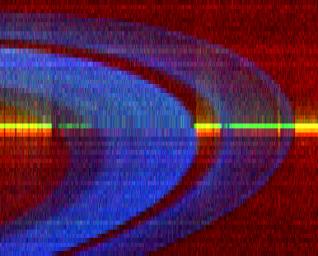
|
Star-Crossed Rings
- Click the image above for a larger view
- Full-Res JPEG (386 x 311) (26.2 kB)
- Full-Res TIFF (386 x 311) (360.7 kB)
Caption:
This image is a false-color ultraviolet view of Saturn's B ring (center) and A ring (right), separated by a large gap known as the Cassini Division. It shows a bright horizontal streak, created by a series of time lapse images involving a star named 26 Taurus.
The image was made over a nine-hour period as the star drifted behind the rings. The opacity of the outer A ring is most pronounced on its inner edge, indicating more ring debris is present there. The Encke Gap, much smaller than the Cassini Division, is visible near the outer edge of the A ring. The B ring is significantly more opaque than the A ring, indicating a greater density of ring material when imaged from above. The sky behind the rings glows red in the ultraviolet wavelengths from the hydrogen gas that fills the solar system.
The images were processed from data taken by the ultraviolet imaging spectrograph aboard the Cassini spacecraft in May 2005.
Background Info:
The Cassini-Huygens mission is a cooperative project of NASA, the European Space Agency and the Italian Space Agency. The Jet Propulsion Laboratory, a division of the California Institute of Technology in Pasadena, manages the mission for NASA's Science Mission Directorate, Washington, D.C. The Cassini orbiter was designed, developed and assembled at JPL. The ultraviolet imaging spectrograph was built at, and the team is based at the University of Colorado, Boulder.
For more information about the Cassini-Huygens mission visit http://saturn.jpl.nasa.gov/home/index.cfm . The ultraviolet imaging spectrograph team home page is at http://lasp.colorado.edu/cassini .
Cataloging Keywords:
| Name | Value | Additional Values |
|---|---|---|
| Target | Saturn Rings | B Ring, Cassini Division, Encke Gap |
| System | Saturn | |
| Target Type | Ring | Gap |
| Mission | Cassini-Huygens | |
| Instrument Host | Cassini Orbiter | |
| Host Type | Orbiter | |
| Instrument | Ultraviolet Imaging Spectrometer (UVIS) | |
| Detector | ||
| Extra Keywords | Color, Ultraviolet, Wave | |
| Acquisition Date | ||
| Release Date | 2006-04-06 | |
| Date in Caption | ||
| Image Credit | NASA/JPL/University of Colorado | |
| Source | photojournal.jpl.nasa.gov/catalog/PIA08036 | |
| Identifier | PIA08036 | |
